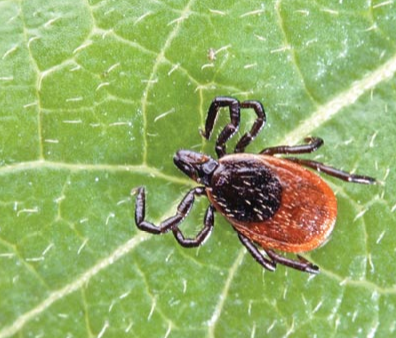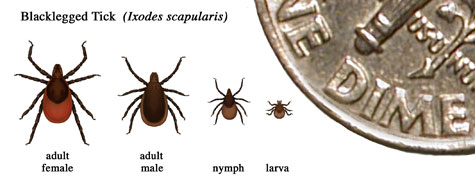Deer Tick (Ixodes scapularis)
Did you just find a Deer Tick on yourself or a loved one? TickCheck can test your tick and determine whether it carries the bacteria that transmit Lyme and other tick-borne infections.
Test My Deer Tick Now
Ixodes scapularis is a small arachnid that survives by feeding on the blood of animals. They are more commonly referred to as the blacklegged or deer tick. Key features in identifying adult female deer ticks include, red-brown coloring of the body, a solid black dorsal shield, lack of festoons along the abdomen, and long, thin mouthparts.
It is responsible for transmitting the causative agents of Lyme disease, babesiosis, bartonellosis, anaplasmosis, and B. miyamotoi.

Where Do Deer Ticks Live?
Although Deer ticks have been identified in every U.S. state except Hawaii, they are most commonly found along the eastern coast of the United States from Florida to Maine and as far west as Texas. They are also located in the Great Lakes region of the upper Midwest United States.
Deer ticks can be found under leaf-litter, at the edges of wooded areas, in areas of high grass or thick vegetation, and areas where wildlife are frequent. They require humid and shaded locations to protect them from drying out and dying.

The Deer Tick's Lifecycle
Ticks have a complicated life cycle which usually last about 2 years. Deer ticks lay eggs in early spring, which hatch in late spring/early summer. Larval ticks are predominant in summer months, during which time they take a blood meal, usually from a small mammal or bird. Larval ticks will over winter, engorge, and molt into nymphs in spring. Nymphs are the common life stage during spring and will take another blood meal, usually from another small to medium sized mammal or bird. Nymphs will molt into adults by fall, at which time adults will feed on large mammals, like bear and deer. Engorged adult ticks will overwinter, lay eggs in the spring, and die.
Are All Deer Ticks Dangerous?
Humans could come into contact with any life stage of tick, although larval encounters would be unusual and difficult to notice because of their small size. Nymphs and adults will regularly feed on humans, and it is thought that nymphs, because they are smaller and more difficult to see, probably cause more cases of Lyme disease than adults.
Research has shown that male deer ticks, while they may appear to attach to a host, will not take a blood meal, and therefore cannot transmit Lyme disease. Therefore, adult female and nymph deer ticks are responsible for the transmission of Lyme disease.
Late spring/early summer and fall are the primary seasons to be aware of ticks, although summer months could also pose hazards. Do not disregard winter—ticks are out when temperatures are above freezing and there is no snow cover. Naturally, risk varies by geographic region.

Deer Tick Behavior
The deer tick will quest when it actively seeks out a host. Deer ticks cannot fly or jump, but they can climb.
Research has found that blacklegged ticks in the southern parts of the U.S. will quest differently than blacklegged ticks in the northern states.
Deer ticks in northern states will climb up blades of grass or other vegetation and stretch out its legs hoping to grab on to a host that is passing by.
Deer ticks in southern states will spend more time under leaf-litter to avoid hot temperatures instead of climbing up plants. This reduces their exposure to humans and will instead find a small mammal or reptile as a host.
Larval deer ticks can climb a few inches from the ground, nymph deer tick will climb up to one foot, and adult deer ticks can climb up to 2 feet off the ground.
Animals That Carry Deer Ticks
Deer ticks will feed on more than 300 different animals. They are most commonly found feeding on shrews, chipmunks, mice, reptiles, birds, domestic animals (dogs), white-tailed deer, moose, and cattle. Of these animals, only mice, chipmunks, birds and shrews can carry and transmit Lyme disease to a feeding tick.

Connect with TickCheck on Facebook for the latest tick news and tips!
